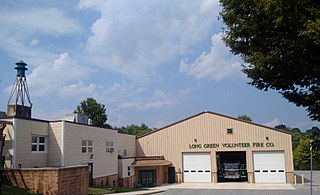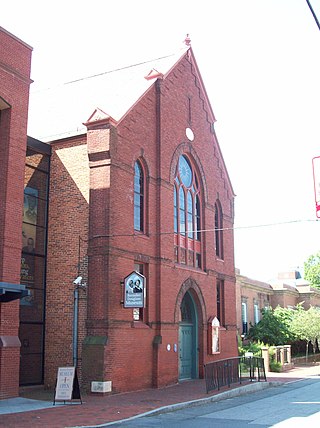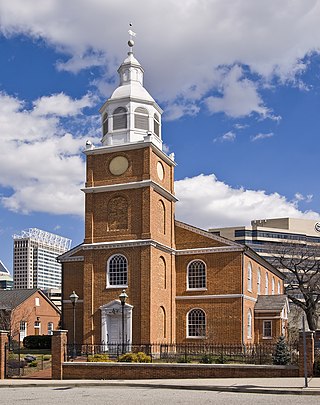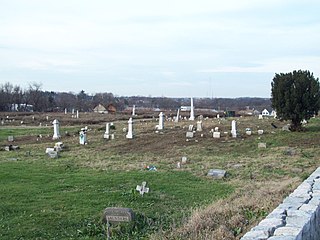
Federal Hill is a neighborhood in Baltimore, Maryland, United States that lies just to the south of the city's central business district. Many of the structures are included in the Federal Hill Historic District, listed on the National Register of Historic Places in 1970. Other structures are included in the Federal Hill South Historic District, listed in 2003.

Mount Vernon is a neighborhood of Baltimore, Maryland, located immediately north of the city's downtown district. Designated a city Cultural District, it is one of the oldest neighborhoods originally home to the city's wealthiest and most fashionable families. The name derives from Mount Vernon, the home of George Washington, given the original Washington Monument, a massive pillar commenced in 1815 to commemorate the first president of the United States, is the defining feature of the neighborhood.
Robert Cary Long Jr. (1810–1849) was the son of a late 18th Century - early 19th Century famous architect Robert Cary Long Sr. of Baltimore, Maryland and was himself a well-known 19th Century architect. Like his father, Cary was based in Baltimore.

Long Green is an unincorporated community in Baltimore County, Maryland, United States. Until 1958, the community was served by the Maryland and Pennsylvania Railroad at milepost 15.8. Prospect Hill was listed on the National Register of Historic Places in 1973.

Seton Hill Historic District is a historic district in Baltimore, Maryland. It was listed on the National Register of Historic Places in 1975.

The Banneker-Douglass Museum, formerly known as Mt. Moriah African Methodist Episcopal Church, is a historic church at Annapolis, Anne Arundel County, Maryland. It was constructed in 1875 and remodeled in 1896. It is a 2+1⁄2-story, gable-front brick church executed in the Gothic Revival style. It served as the meeting hall for the First African Methodist Episcopal Church, originally formed in the 1790s, for nearly 100 years. It was leased to the Maryland Commission on African-American History and Culture, becoming the state's official museum for African-American history and culture. In 1984, a 2+1⁄2-story addition was added when the building opened as the Banneker-Douglass Museum.

Johnsville is an unincorporated community in Frederick County, Maryland, United States. It is located approximately halfway between Libertytown and Union Bridge along Maryland Route 75. The Kitterman-Buckey Farm was listed on the National Register of Historic Places in 2005.

Madison Avenue Methodist Episcopal Church, now known as Douglas Memorial Community Church, is a historic Methodist Episcopal church located at Baltimore, Maryland, United States. It is a brick, Greek Revival, temple-fronted structure featuring four fluted Corinthian columns and built 1857–1858. The rear addition is a two-story Colonial Revival style wing dating from about 1900.

Otterbein Church, now known as Old Otterbein United Methodist Church, is a historic United Brethren church located in Baltimore, Maryland, United States. The first "German Reformed" church was built to serve the German Reformed and some Evangelical Lutheran immigrants, and later entered the Brethren strain of German Reformed Protestantism in the later Church of the United Brethren in Christ.

Orchard Street United Methodist Church, formerly known as Metropolitan Methodist Episcopal Church, is a historic Methodist Episcopal church located at Baltimore, Maryland, United States. It is a church built in a mixture of revival styles. It was constructed in 1837, with additions made in 1853, 1865, and 1882. The main church is Romanesque Revival, but the rear building is Romanesque with a large Gothic window in its northeastern facade. The nave is approximately 54 by 75 feet and features clerestory windows. The rear building is approximately 50 by 75 feet. The church was founded in 1825 by Truman Le Pratt, a West Indian former slave of Governor John Eager Howard. It now houses the offices of the Baltimore Urban League and is the oldest standing structure built by African-Americans in the city of Baltimore.

Lovely Lane United Methodist Church, formerly known as First Methodist Episcopal Church and earlier founded as Lovely Lane Chapel, is a historic United Methodist church located at Baltimore, Maryland, United States.

St. John's Episcopal Church, also known as St John's in the Village, is a nineteenth-century Episcopal church building on Old York Road in the former village of Huntingdon (now the community of Waverly in northeast Baltimore, Maryland, United States. The congregation is often referred to as "St. John's of Huntingdon Episcopal Church". It is a Gothic Revival structure built originally in 1847. Also on the property is a cemetery.

St. Alphonsus Church, Rectory, Convent and Halle, also known as St. John Neumann Shrine and "Baltimore's Powerhouse of Prayer," is a historic Roman Catholic church complex located within the Archdiocese of Baltimore in Baltimore, Maryland, United States. Since 1992, the parish has held regular Tridentine Masses. It is currently administered by the Priestly Fraternity of Saint Peter.

Dorguth Memorial United Methodist Church, formerly known as Otterbein Chapel Station, Scott Street United Brethren Church, Dorguth Memorial United Brethren Church, and Dorguth Memorial Evangelical United Brethren Church, is a historic United Methodist church located at Baltimore, Maryland, United States. It was built in 1857 and is a simple, two-story gable-front brick church of the late Roman Revival style. It features a gabled roof with a pedimented brick cornice. Also on the property is the parish house added in 1868.> The church was named for Mrs. Frederick Dorguth, who in 1936 left money for extensive renovations. Dorguth UMC closed its doors in 2001.

Leadenhall Street Baptist Church is a historic Baptist church located at Baltimore, Maryland, United States. It is a gable-front rectangular brick temple with simple Renaissance Revival detail. The original exterior wall surfaces have been covered with formstone on the main façade and stucco elsewhere. It features round-arched stained glass windows on each side bay. It was built in 1873, by Joseph Thomas & Son for the city's African American Baptists who were then centered in the old southwest area from the downtown business district of Baltimore in the "Sharp-Leadenhall" community in the old "South Baltimore" area. Nearby is its now famed revitalized "Inner Harbor" area of the old "Basin" for the harbor port.

Mount Auburn Cemetery is a historic African American cemetery and national historic district in Baltimore, Maryland, United States. Overlooking the Middle Branch of the Patapsco River to the east, Baltimore's Downtown to the north and railroad tracks to the south, Mt. Auburn Cemetery is surrounded by the Cherry Hill, Westport, Mt. Winans and Lakeland communities.

Old Goucher College Buildings is a national historic district in Baltimore, Maryland, United States. It is an approximate 18-block area in the middle of Baltimore which developed in the late 19th and 20th centuries.

Green Spring Valley Historic District is a national historic district near Stevenson in Baltimore County, Maryland, United States. It is a suburban area of Baltimore that acquires significance from the collection of 18th, 19th, and early 20th century buildings. The park-like setting retains a late 19th-early 20th century atmosphere. At the turn of the 20th century, the Maryland Hunt Cup and the Grand National Maryland steeplechase races were run over various parts of the valley. The Maryland Hunt Cup, which began as a competition between the Green Spring Valley Hunt and the Elkridge Hunt, traditionally started at Brooklandwood, the previous home of Charles Carrol of Carrollton with the finish across Valley Road at Oakdene, at that time the home of Thomas Deford, which remains a private residence

The Union Baptist Church is a historic Baptist church building located at 1219 Druid Hill Avenue in central Baltimore, Maryland. The granite church was designed by New York architect William J. Beardsley and built in 1905 under the leadership of Rev. Harvey Johnson. The Gothic Revival structure features steeply pitched roofs, lancet windows, and distinctive buttressing on the front facade to provide support for the walls on a constrained lot size. The church was built for a predominantly African-American congregation established in 1852; its minister from 1872 to 1923, Rev. Harvey Johnson, was a prominent voice in the civil rights movement.
African Academy, the first permanent school in Baltimore, Maryland for African Americans. It was located at 112–116 Sharp Street, between Lombard and Pratt.























